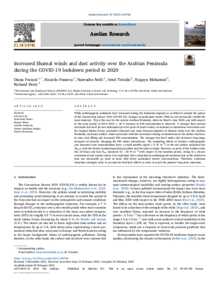Document
Increased Shamal winds and dust activity over the Arabian Peninsula during the COVID-19 lockdown period in 2020.
Identifier
DOI: 10.1016/j.aeolia.2022.100786
Source
Aeolian Research. v. 55, 100786
Contributors
Fonseca, Ricardo., Author
Nelli, Narendra., Author
Teixido, Oriol., Author
Mohamed, Ruqaya., Author
Perry, Richard., Author
Country
Netherlands.
Publisher
Elsevier B.V.
Gregorian
2022-03-01
Language
English
English abstract
While anthropogenic pollutants have decreased during the lockdown imposed as an effort to contain the spread of the Coronavirus disease 2019 (COVID-19), changes in particulate matter (PM) do not necessarily exhibit the same tendency. This is the case for the eastern Arabian Peninsula, where in March–June 2020, and with respect to the same period in 2016–2019, a 30 % increase in PM concentration is observed. A stronger than normal nocturnal low-level jet and subtropical jet over parts of Saudi Arabia, in response to anomalous convection over the tropical Indian Ocean, promoted enhanced and more frequent episodes of Shamal winds over the Arabian Peninsula. Increased surface winds associated with the downward mixing of momentum to the surface fostered, in turn, dust lifting and increased PM concentrations. The stronger low-level winds also favoured long-range transport of aerosols, changing the PM values downstream. The competing effects of reduced anthropogenic and increased dust concentrations leave a small positive signal (5 W m−2) in the net surface radiation flux (Rnet), with the former dominating during daytime and the latter at night. However, in parts of the Arabian Gulf, Sea of Oman and Iran Rnet increased by >20 W m−2 with respect to the baseline period, owing to a clearer environment and weaker winds. It is concluded that a reduction in anthropogenic emissions due to the lockdown does not necessarily go hand in hand with lower particulate matter concentrations. Therefore, emissions reduction strategies need to account for feedback effects in order to reach the planned long-term outcomes.
ISSN
1875-9637
Category
Journal articles

